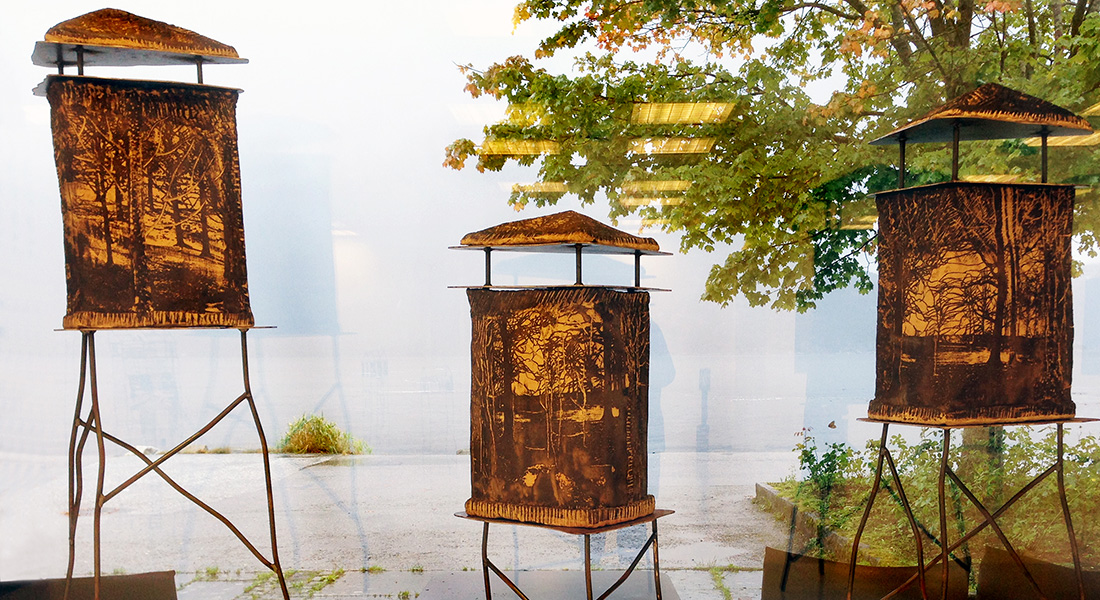FROZEN MUSIC
an exhibition at Haa Gamle Prestegaard, Norway in june-september 2016
The title is Goethes definition of architecture: ”Architecture is a frozen music”.
Concept for this exhibition is influenced by the exhibition space itself, a raw basement of the light house that has not been in use since the war and is under renovaton right now. I have always taken the exhibition space into consideration, when I was looking for an exhibition idea. I have always been aware of the surroundings for my work, what people see on the way to my exhibition and what do they see, think and do after. My ambition has always been grander than just showing my work, I have always wished to leave a memory behind in people´s eyes and souls.
Since 2012 I have revisited my ceramic research about application of photography on ceramics, using my old project about architectural images, stairs, arches and windows applied onto ceramic sculptural forms. My first big exhibition on this same subject has been my first big exhibition at Henie-Onstad art center outside Oslo in 1988-89. See ”Blue and fireproof” under ”projects” on www.galina.no.
This time my photographic images originate from different countries and styles of architecture. Forms and structures they are applied to are created to connect to the rooms around with their existing materials and colors. The result is a mixture of references, assosiations, forms and languages. My own nature and personal background force my work to be both complex and complicated. The stories I want to tell are either laconic or simple, perhaps too hard to interprete or to understand for the viewers. But all my projects have always several layers and can be read and experienced in many different ways. My purpose has never been to satisfy the crowds, but to tell a story.
I use applied photography as a medium for all my work. It has been my special field o finterest and expertise during the last 40 years. My techniques are unique, experimental and unknown to many people. The same can be stated about my use of materials, colors and forms. I never cared for being a part of some particular style, technique or material based art field. My work is therefore often hard to define as ”photography”, ”sculpture” or ”installation”. It never fits into any frame.
I have always tried to create my own world without borders or limits in regard to forms of expression, theme, material and technique. Public entering my exhibition space might be surprized or shoked, curious or provoked. The most important thing for me is to complete a project up to a certain stage, but leave enough space for fantasy and interpretation by every viewer according to the level of knowledge, education and experience they have. Every art work needs to function on several levels and have many layers, so it can be seen in a new light later on.
Obrestad lighthouse has a little room on the way down the stairs to ”my” exhibition space consisting of three rooms with very thick stone walls and big windows sitting deep inside. The little room under the stairs is decorated with a ”pin-up” girl painted there by a German soldier during the war. This is the first artistic impression the visitors are offered, when they enter the space.
Somehow I wanted to give a reference to this piece of history from the last war. Maybe that is the reason for using iron for this project, connecting it to wire fences and prison spaces.
The sculptures are made of iron wires and steel plates with elements of high-fired fragile porcelain paper and ceramics. Stairs, arches, windows and construction structures give some associations and commentaries to towers, lighthouses and fences enfasizing on contrasts of textures, forms, sizes, strengths and weaknesses of the materials used.
There are many different elements exposed in the three small basement rooms of the Obrestad light house. There is a video-projection in the smallest room. The videofilm relates to all the other elements of this project, making a comment and a possible interpretation easier for the visitors.
Light and sound are supposed to underline the concept and activate other senses in addition to the visual impressions.





















































































































